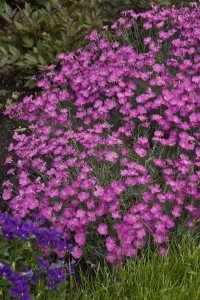
Bath's Pink Cheddar pinks dianthus sprawls onto the pavement. The blue-green foliate is evergreen and withstands getting dumped with snow shoveled from the driveway. (C) Jo Ellen Meyers Sharp
Dianthus has great scents.
In fact, the scent tells you it’s a dianthus, whether what you smell is a sweet William, a carnation or a pink.
Dianthus means “flower of the gods” in Greek, and is in an even larger family of plants known for their fragrance, such as the clove tree. Indeed, clove is frequently the word used to describe dianthus’ spicy scent.
There are annual, biennial and perennial dianthus, and many have weak stems, which give them a sprawling characteristic, especially carnation.
Hybridizers have improved the heat tolerance for dianthus, especially the group of perennials called Cheddar pinks. In face, Cheddar pinks are about as tough as you want a plant to be.
Annual seeds can be started indoors six or eight weeks before the last frost, which in central Indiana is May 10. Bedding plants are readily available at area garden centers, too.
Some of the better new annuals grown as bedding plants include the yummy ‘Parfait’ series, and the ‘Corona Cherry Magic,’ a 2003 All-America Selections bedding plant winner. Another 2003 AAS winner, ‘Can-Can Scarlet,’ is an incredibly fragrant, 2-foot tall plant ideal for cutting. And, although marketed as somewhat heat tolerant, in my yard, it slowed way down last summer, but came back just fine once the weather cooled.

Firewitch Cheddar pink dianthus was the 2006 Perennial Plant of the Year. Photo courtesy perennialresource.com
For perennials, you can’t beat the heat tolerant ‘Bath’s Pink’ (Dianthus gratianopolitanus) or the deep red ‘Zing’ (D. deltoides), a lovely sprawling, drought and heat tolerant plants. The Perennial Plant Association named ‘Feuerhexe’, marketed as Firewitch, as its plant of the year in 2006. It blooms off and on throughout the summer. These perennials are terrific alternatives to regular, ordinary ground covers.
The foliage on Cheddar pinks is evergreen, holding its own in winter weather. These plants get their name Cheddar, because they come from the Cheddar area of England. The pinks comes because the flowers look like they were trimmed with pinking shears.
Dianthus does best in full sun (six or more hours a day) and well drained soil. Maiden pink (D. deltoides) and biennial sweet William (D. barbatus) tolerate part shade.
After the first flush of flowers in spring or early summer, shear the plant back an inch or two and it will likely produce blooms intermittently throughout summer and into fall. Deadheading, or snipping off the spent flowers, will extend the bloom period, too.
Dianthus is a great way to spice up a room, too. The flowers last about two weeks in a vase.
